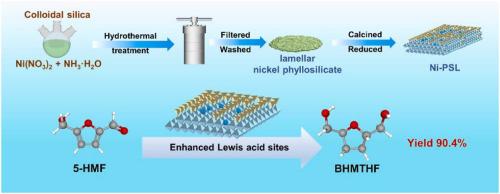当前位置:
X-MOL 学术
›
Catal. Today
›
论文详情
Our official English website, www.x-mol.net, welcomes your
feedback! (Note: you will need to create a separate account there.)
Engineered nickel phyllosilicate for selective 5-HMF C–O bond hydrogenation under benign conditions
Catalysis Today ( IF 5.2 ) Pub Date : 2024-06-07 , DOI: 10.1016/j.cattod.2024.114883 Xianghui Wang , Qiaofeng Liu , Shiyi Chen , Xiaoqi Qian , Qihui Huang , Xufeng Liu , Linmin Ye , Youzhu Yuan
Catalysis Today ( IF 5.2 ) Pub Date : 2024-06-07 , DOI: 10.1016/j.cattod.2024.114883 Xianghui Wang , Qiaofeng Liu , Shiyi Chen , Xiaoqi Qian , Qihui Huang , Xufeng Liu , Linmin Ye , Youzhu Yuan

|
The selective transformation of biomass-derived 5-hydroxymethylfurfural (5-HMF) into value-added chemicals is of significant interest to both academia and industry. In this study, we report on the direct hydrogenation of 5-HMF to 2,5-bis(hydroxymethyl)tetrahydrofuran (BHMTHF) instead of 2,5-dimethylfuran, achieving an impressive yield of 90.4% in 7 runs using a nickel phyllosilicate catalyst (Ni-PSL) under optimized conditions. The choice of solvent is crucial for minimizing side reactions, with tetrahydrofuran identified as an optimal solvent for reducing the formation of acetal by-products, which are typically promoted by protic organic solvents such as methanol or -butanol. Pyridine–FTIR results reveal that the surface of Ni-PSL is enriched with Lewis acid sites, originating from coordinatively unsaturated Ni species, which are effectively generated through proper thermal treatment. Moreover, the total amount of acid sites in Ni-PSL can be modulated by adjusting the calcination temperature, without affecting the size of the Ni nanoparticles. These Lewis acid sites play pivotal roles in promoting the adsorption of the furan ring, thereby favoring the formation of BHMTHF under mild reaction conditions. However, an excess of Lewis acid sites promotes the cleavage of the C−OH bond, reducing the selectivity towards DMTHF.
中文翻译:

用于在良性条件下选择性 5-HMF C-O 键氢化的工程页硅酸镍
将生物质衍生的 5-羟甲基糠醛 (5-HMF) 选择性转化为增值化学品引起了学术界和工业界的极大兴趣。在这项研究中,我们报告了将 5-HMF 直接氢化为 2,5-双(羟甲基)四氢呋喃 (BHMTHF) 而不是 2,5-二甲基呋喃,使用页硅酸镍催化剂在 7 次运行中实现了 90.4% 的令人印象深刻的产率(Ni-PSL)在优化条件下。溶剂的选择对于最大限度地减少副反应至关重要,四氢呋喃被认为是减少缩醛副产物形成的最佳溶剂,而缩醛副产物通常由质子有机溶剂(例如甲醇或正丁醇)促进。吡啶-FTIR 结果表明,Ni-PSL 的表面富含路易斯酸位点,这些酸位点源自配位不饱和镍物质,这些物质是通过适当的热处理有效生成的。此外,Ni-PSL中酸性位点的总量可以通过调节煅烧温度来调节,而不影响Ni纳米颗粒的尺寸。这些路易斯酸位点在促进呋喃环的吸附方面发挥着关键作用,从而有利于在温和的反应条件下形成BHMTHF。然而,过量的路易斯酸位点会促进 C−OH 键的断裂,从而降低对 DMTHF 的选择性。
更新日期:2024-06-07
中文翻译:

用于在良性条件下选择性 5-HMF C-O 键氢化的工程页硅酸镍
将生物质衍生的 5-羟甲基糠醛 (5-HMF) 选择性转化为增值化学品引起了学术界和工业界的极大兴趣。在这项研究中,我们报告了将 5-HMF 直接氢化为 2,5-双(羟甲基)四氢呋喃 (BHMTHF) 而不是 2,5-二甲基呋喃,使用页硅酸镍催化剂在 7 次运行中实现了 90.4% 的令人印象深刻的产率(Ni-PSL)在优化条件下。溶剂的选择对于最大限度地减少副反应至关重要,四氢呋喃被认为是减少缩醛副产物形成的最佳溶剂,而缩醛副产物通常由质子有机溶剂(例如甲醇或正丁醇)促进。吡啶-FTIR 结果表明,Ni-PSL 的表面富含路易斯酸位点,这些酸位点源自配位不饱和镍物质,这些物质是通过适当的热处理有效生成的。此外,Ni-PSL中酸性位点的总量可以通过调节煅烧温度来调节,而不影响Ni纳米颗粒的尺寸。这些路易斯酸位点在促进呋喃环的吸附方面发挥着关键作用,从而有利于在温和的反应条件下形成BHMTHF。然而,过量的路易斯酸位点会促进 C−OH 键的断裂,从而降低对 DMTHF 的选择性。





















































 京公网安备 11010802027423号
京公网安备 11010802027423号